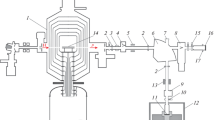Abstract
A KNOWLEDGE of the spectral composition of the feeble luminosity arising from the passage of energetic ions through gases is essential to the complete understanding of the processes by which the ions lose energy along their tracks. It also has important applications to the physics of the aurora (part of which is excited by traversal through the high atmosphere of solar protons), and in the efficient use of gas scintillators in nuclear physics.
Similar content being viewed by others
References
Nicholls, R. W., and Pleiter, D., Nature, 178, 1456 (1956).
Nicholls, R. W., Amer. J. Phys., 22, 59 (1954).
Fraser, P. A., Amer. J. Phys., 22, 220 (1954).
Pearse, R. W. B., and Gaydon, A. G., “The Identification of Molecular Spectra”, 2nd edit. (Chapman and Hall, 1950).
Huggins, Sir Wm., and Huggins, Lady, Proc. Roy. Soc., A, 72, 196 (1903); 76, 488 (1905); 77, 130 (1906).
Ortner, G., and Salim, S., Nature, 169, 1060 (1952).
Author information
Authors and Affiliations
Rights and permissions
About this article
Cite this article
NICHOLLS, R., REEVES, E. Luminescence produced in Air by Polonium-210 α-Particles. Nature 180, 1188–1189 (1957). https://doi.org/10.1038/1801188a0
Issue Date:
DOI: https://doi.org/10.1038/1801188a0
- Springer Nature Limited




